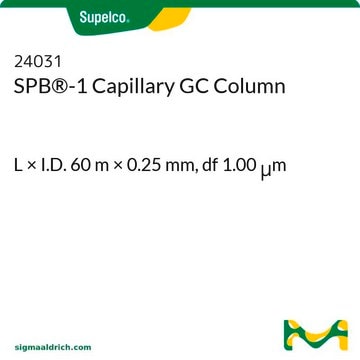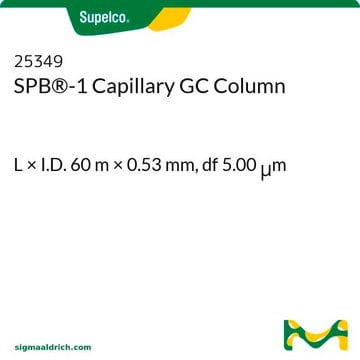24158
SPB®-1 SULFUR Capillary GC Column
L × I.D. 30 m × 0.32 mm, df 4.00 μm
Synonym(s):
SPB-1 Sulfur
Sign Into View Organizational & Contract Pricing
All Photos(1)
About This Item
UNSPSC Code:
41115710
Recommended Products
material
fused silica
parameter
-60-300 °C temperature (isothermal or programmed)
Beta value
20
df
4.00 μm
technique(s)
gas chromatography (GC): suitable
L × I.D.
30 m × 0.32 mm
matrix active group
Bonded; poly(dimethyl siloxane) phase
application(s)
chemicals and industrial polymers
food and beverages
petroleum
column type
capillary non-polar
General description
Application: A specialized version of the SPB-1, this column was developed for analyses of sulfur gases and other volatile sulfur compounds. The column displays relatively low column bleed, which makes it compatible for use with sulfur-specific detectors.
USP Code: This column meets USP G1, G2, and G9 requirements.
Phase
USP Code: This column meets USP G1, G2, and G9 requirements.
Phase
- Bonded
- Poly(dimethyl siloxane)
- -60 °C to 300 °C (isothermal or programmed)
Other Notes
We offer a variety of chromatography accessories including analytical syringes
Legal Information
SPB is a registered trademark of Merck KGaA, Darmstadt, Germany
Choose from one of the most recent versions:
Already Own This Product?
Find documentation for the products that you have recently purchased in the Document Library.
Customers Also Viewed
Gas chromatography double focusing sector-field ICP-MS as an innovative tool for bad breath.
Julio R
Journal of Analytical Atomic Spectrometry, 16 (9), 1051-1056 (2001)
Headspace GC-SCD monitoring of low volatile sulfur compounds during fermentation and in wine.
Rahut D
Analusis, 26 (3), 142-144 (1998)
Larry D Lawson et al.
Nutrients, 10(7) (2018-06-26)
Allicin is considered responsible for most of the pharmacological activity of crushed raw garlic cloves. However, when garlic supplements and garlic foods are consumed, allicin bioavailability or bioequivalence (ABB) has been unknown and in question because allicin formation from alliin
Chromatograms
suitable for GC, application for SPMEsuitable for GC, application for SPMEsuitable for GC, application for SPMEsuitable for GC, application for SPMEShow MoreOur team of scientists has experience in all areas of research including Life Science, Material Science, Chemical Synthesis, Chromatography, Analytical and many others.
Contact Technical Service





